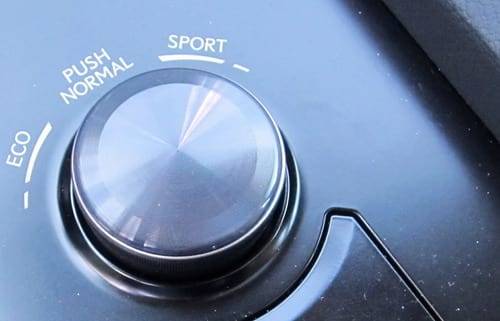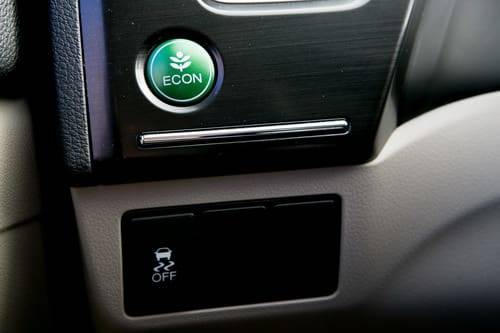Do All Those Driving Modes Affect a Car's EPA Gas Mileage?


CARS.COM — Technology is taking a lot of the “driving” out of today’s cars, whether with advanced safety nannies like lane departure systems or sports cars with advanced automatic transmissions. But one piece of burgeoning technology promises to deliver better gas mileage at the push of a button.
Related: What Does This Button Do?
It isn’t just luxury vehicles that have these selectable driving mode buttons. Models as plebeian as the Honda Civic and Dodge Grand Caravan have fuel-saving economy modes; others, like the Nissan Altima and Honda Accord, have Sport modes.
But do EPA fuel-economy ratings reflect this technology? It depends.
These selectable driving modes can dial in mileage-saving economy settings alongside a Normal mode. Others have more options besides efficiency for Sport and sometimes Super Sport modes. The sportier driving modes seldom alter engine performance — rather, they influence factors like gas-pedal sensitivity, automatic-transmission shift patterns and steering feedback. Some Sport modes can even dial back an electronic stability system or hunker down an adaptive suspension to sharpen handling. A number of economy programs, in turn, can restrain the air conditioning in the name of eking out more miles per gallon.
Such programs certainly affect real-world MPG. A more sensitive accelerator or kickdown-happy transmission often trades fuel efficiency for performance; relaxing those inputs with a mode geared toward fuel efficiency, by contrast, guzzles less fuel at the expense of excitement behind the wheel. The differences can be significant: In an unscientific mileage drive in 2009, we observed that driving in Sport mode could slash mileage as much as 11 percent.
How does the EPA take all of this into account?
“All EPA ratings are done in the Normal mode,” Honda spokesman Chris Martin said of the Civic and Accord, which have Eco and Sport modes, respectively. “EPA ratings are trying to create an apples-to-apples comparison between models, which is best done in a default normal driving mode.”

Honda is but one example. The EPA sent us a statement along with a 2009 policy document that said it would handle such driver-selectable systems “on a case-by-case basis.” Here’s how it shakes out:
- If a vehicle has various drive modes but defaults back to Normal whenever you turn the engine back on, the EPA draws its fuel-economy ratings from the Normal mode.
- But vehicles that default to a fuel-saving mode at start-up — like the 2014 Jeep Grand Cherokee — set economy as the “predominant” drive mode from which the EPA bases its MPG ratings, the agency told us.
- If a vehicle has drive-mode system that stays in whatever you last drove, the EPA may not be able to establish a “predominant” mode. In such cases, “the vehicle is tested in the various modes and the fuel economy results from the best and worst modes are harmonically averaged,” EPA officials wrote. “For example, if a vehicle has a sport mode, normal mode, and economy mode, the fuel economy results of the sport and economy modes would be averaged.”
- Automakers can (and often do) submit customer surveys or technical data that show that customers use one particular mode in their vehicles most of the time — so if Honda determined that 80 percent of Civic owners drove everywhere in Econ mode, then it could request that the EPA rerate the Civic using economy-mode driving. If it’s too early to assess the mode that drivers use most often — say, with a fresh redesign or introduction — then automakers can exercise “good engineering judgment” to determine what’s predominant, the EPA said.
The upshot? If your car stays in the drive mode you left it the last time you drove, chances are good the EPA window-sticker mileage reflects some or all of its driving modes. But if your car defaults back to a baseline mode, chances are the EPA’s mileage estimate only reflects that mode. That’s why those window stickers say, as always, that your vehicle’s mileage may vary.
Cars.com’s Editorial department is your source for automotive news and reviews. In line with Cars.com’s long-standing ethics policy, editors and reviewers don’t accept gifts or free trips from automakers. The Editorial department is independent of Cars.com’s advertising, sales and sponsored content departments.

Former Assistant Managing Editor-News Kelsey Mays likes quality, reliability, safety and practicality. But he also likes a fair price.
Featured stories




